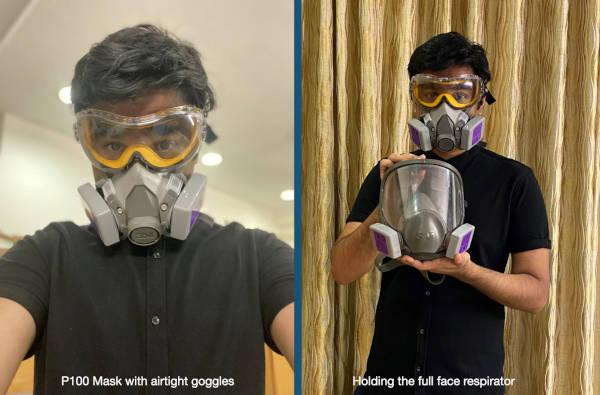May 22, 2021 | FF Daily #378
Good morning,
As the second wave ravages the country, two important facets about the virus have emerged in recent weeks.
Many of us are amply familiar with the first—that the virus has mutated to a more infectious form. The less familiar news is an update around how WHO and CDC believe the virus spreads. It now includes aerosol transmission, in addition to droplet transmission.
Make no mistake, the implications of this change are extremely significant. It means, in addition to close contact spread, transmissions might also occur over longer ranges, especially in poorly ventilated and/or crowded indoor settings, since aerosols remain suspended in the air or travel farther than 1 meter.
Our initial reaction can be of puzzlement around why it took so long for WHO and CDC to accept the facts around Covid transmission. It can be followed by rage, given it’s somewhat unethical of the institutions to have silently backtracked on their position they earlier argued aggressively for—without any news conference or big announcement.
The important question, however, is the one that follows.
Now that we know the virus is more infectious and can spread over longer ranges, how do we enhance our safety and the safety of our loved ones?
Especially given our best weapon—vaccines—are currently in short supply and it will be months before we all are vaccinated.
This edition of #FFRecommends details four upgrades you can make to avoid catching the virus.
4. Buy your mask from a reputed manufacturer with a history of making PPE
Level: Bringing a fist to a gunfight
Have you seen that movie where the villain suddenly fires his pistol, only to realise the hero had removed the bullets/magazine of his gun when they shook hands earlier?
Well, we are shooting blanks too if we are wearing a fake mask.
Recently in Canada, CBC News bought masks from Walmart, Amazon and other prominent stores and tested their authenticity in partnership with Dalla Lana School of Public Health. Turns out 50% of the N95 masks were fake. Some of them offered less protection than a towel would.
With so many players entering the PPE market, this is unfortunately true for India too.
The way out? First, attempt to buy a mask directly from a manufacturer (avoid resellers if possible) with a demonstrated expertise in PPEs. While Honeywell, Venus, Magnum are known to be reputed brands, my personal recommendation is 3M. They are simply world class.
However, the rot has set around them too. There are several pretend vendors selling fake 3M masks on Amazon—as the comments on the website reveal. Thankfully, 3M offers verification on its website which allows you to match the secure code and lot code on the box to ascertain the authenticity. I personally find this process reassuring and avoid using other proxies to judge the quality, such as Amazon choice or customer ratings.
Stay tuned! The best way to avoid the fake mask mess altogether is covered in the last section.
3. Get into the habit of checking the seal of your mask
Level: Bringing a knife to a gunfight
One of the most ludicrous, yet impactful TED talks is how to tie your shoes. Imagine the reaction of thousands of the smartest folks when they realised they got this seemingly simple process wrong for years.
I got a sense of how the audience might have felt when I recently discovered I was wearing my mask incorrectly. This was when my geeky friend Bittu nudged me to do a seal test.
It’s a simple process where after donning the mask, you cover it with your hands, and inhale/exhale to check for leaks. The step by step process is outlined in the video below.
I realised my mask wasn’t airtight and was leaking, exposing me to the risks of aerosol spread. I hadn’t shaved for days, which was impacting the mask fit. It took a few minutes of adjustment to eventually get the fit right. Since then, I always do a seal test.
It’s important to note that an inferior mask worn properly is better than a superior quality mask worn incorrectly.
I must admit, however, that the tough part is getting into the habit of doing the seal test. We are often in a rush to wear the mask, perhaps because it’s an irritating process. The seal test adds to the chore. I have had my struggles with my Dad who tried to skip it on one occasion and took some convincing. The struggle was worth the critical upgrade in protection.
As a rule of thumb, I feel if you are spending less than 3 minutes wearing and adjusting a mask, you may not be wearing it well. It takes that long and multiple attempts to get the fit right.
2. Supplement your mask with eye protection
Level: Bringing a gun to a gunfight
The virus can enter via our eyes, nose, or mouth. The mask protects only the latter two. The eyes still need protection and it might be an important missing key.
Surprisingly when we step out, we rarely see people placing emphasis on eye protection. At the least, I would advise wearing glasses and/or a face shield. They would protect from droplet transmissions.
However, to protect against aerosol transmission, one needs airtight goggles, which provide a good face seal and are anti-fog. Based on a doctor’s recommendation, who shared his personal gear, I have purchased these.
1. Replace N95 with P100 masks
Level: Bringing a Rafale jet to a gunfight
N95 masks are often hailed as the best masks as they filter 95% of the particles greater than 0.3 micron. However, they pale in comparison to P100 masks, which filter 99.97%.
(Fun fact: Did you know masks are great at filtering extremely large and extremely small particles, but it’s the medium-sized particles they struggle with? Here’s a video that explains the astounding physics of N95 masks.
Once you know the physics, you will also realise why washing an N95 mask is a cardinal sin. It significantly reduces the filtration.)
Many savvy doctors in the Covid ward actually donn the P100 mask (3M 6000 series) and consider them to be the best mask.
And guess what? While they look sophisticated, they are cheaper than N95 masks. This is because N95 masks soil quickly and can’t be reused after a while, meaning one needs to keep buying them.
A single P100 mask on the other hand can last for several months, if not years. Each one costs only about Rs 3,000. One needs to only replace the filter every 6-12 months, which costs approximately Rs 800.
They also fit better, as the straps are flexible, unlike an N95 mask where the straps can stretch only to a limited extent. Finally, given the sophisticated design of the mask and how niche it is, fakes do not play spoilsport.
I have gone a step ahead and not just purchased the P100 mask, but also the full face respirator (3M 6800) which is a bit expensive at Rs 10,000. (As you can guess, I am into gadgets. Plus my friend Bittu made a compelling case.)
I plan to use the respirator when I am going to be in a high risk situation for long periods. The investment came in handy recently, when I had to queue for over 5 hours in an indoor hall with over 200 people, with no social distancing, to get vaccinated.

So far, my enthusiasm has rubbed off on eight others, who have made the shift. For the rest, the usual pushback I receive is that it might be uncomfortable to wear.
There might be some truth to this—some of my friends’ parents did take some time to get used to it. Personally, I found these masks to be more comfortable than N95 masks.
That’s because the part that sits snugly on your face is well designed and made of plastic and rubber. It makes the fit very smooth, comfortable and durable. Secondly, this mask has a one-way exhale valve that improves ventilation. N95 masks (with no exhale valves) often heat up due to the air getting trapped, making it very uncomfortable to wear for longer periods of time.
In case you are wondering if the exhale valve would enhance your comfort but lead to inferior protection for those around you, according to CDC even with an exhale valve, P100 or N95 masks offer better protection to others than wearing surgical or cloth masks. Some people including a few doctors, as a matter of ethics, place an additional surgical mask at the exhale valve to further enhance the protection the mask offers to others.
If you decide to buy it, here’s a video on how to wear it properly and do the seal test. It’s slightly different from the N95 mask. (And here’s a link to a similar video for the full mask respirator.)
The other pushback I have received is that the mask stands out or looks a bit scary; and whether we really need to escalate our protection so much. If you are one of those, I leave you with the same thought I started with: The virus has upgraded itself. Have you?


